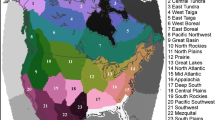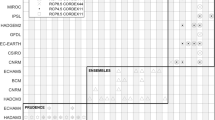Abstract
Regional climate projections using climate models commonly use an “all-model” ensemble based on data sets such as the Intergovernmental Panel on Climate Change’s (IPCC) 4th Assessment (AR4). Some regional assessments have omitted models based on specific criteria. We use a criteria based on the capacity of climate models to simulate the observed probability density function calculated using daily data, model-by-model and region-by-region for each of the AR4 models over Australia. We demonstrate that by omitting those climate models with relatively weak skill in simulating the observed probability density functions of maximum and minimum temperature and precipitation, different regional projections are obtained. Differences include: larger increases in the mean maximum and mean minimum temperatures, but smaller increases in the annual maximum and minimum temperatures. There is little impact on mean precipitation but the better models simulate a larger increase in the annual rainfall event combined with a larger decrease in the number of rain days. The weaker models bias the amount of mean warming towards lower increases, bias annual maximum temperatures to excessive warming and bias precipitation such that the amount of the annual rainfall event is under-estimated. We suggest that omitting weak models from regional scale estimates of future climate change helps clarify the nature and scale of the projected impacts of global warming.
Similar content being viewed by others
References
Beaumont L, Pitman AJ, Hughes L, Poulsen M (2007) Within and between climate model variability in the simulation of the impact of climate change on butterfly species in Australia. Glob Chang Biol 13:1368–1385. doi:10.1111/j.1365-2486.2007.01357.x
Christensen JH, Hewitson B, Busuioc A, Chen A, Gao X, Held I, Jones R, Kwon W-T, Laprise R, Rueda VM, Mearns L, Menéndez CG, Räisänen J, Rinke A, Kolli RK, Sarr A, Whetton P (2007) Regional climate projections. In: Solomon S, Qin D, Manning M, Chen Z, Marquis M, Averyt KB, Tignor M, Miller HL (eds) Climate change 2007: the scientific basis. Contribution of working group I to the fourth assessment report of the intergovernmental panel on climate change. Cambridge University Press, New York
Colombo A, Etkin D, Karney B (1999) Climate variability and the frequency of extreme temperature events for nine sites across Canada: implications for power usage. J Climate 12:2490–2502
Easterling DR, Meehl GA, Parmesan C, Changnon SA, Karl TR, Mearns LO (2000) Climate extremes: observations, modeling, and impacts. Science 289:2068–2074
Griffiths GM, Chambers LE, Haylock MR, Manton MJ, Nicholls N, Baek H-J, Choi Y, Della-Marta PM, Gosai A, Iga B, Laurent V, Maitrepierre L, Nakamigawa H, Ouprasitwong N, Solofa D, Tahani L, Thuy DT, Tibig L, Trewin B, Vediapan K, Zhai P (2005) Change in mean temperature as a predictor of extreme temperature change in the Asia-Pacific region. Int J Clim 25:1301–1330
Hennessy KJ, Pittock AB (1995) Greenhouse warming and threshold temperature events in Victoria, Australia. Int J Climatol 15:591–612
Johns TC, Durman CF, Banks HT, Roberts MJ, Mclaren AJ, Ridley JK, Senior CA, Williams KD, Jones A, Rickard GJ, Cusack S, Ingram WJ, Crucifix M, Sexton DMH, Joshi MM, Dong B-W, Spencer H, Hill RSR, Gregory JM, Keen AB, Pardaens AK, Lowe JA, Bodas-Salcedo A, Stark S, Searl Y (2006) The New Hadley Centre climate model (HadGEM1): evaluation of coupled simulations. J Climate 19:1327–1353
Katz R, Brown B (1992) Extreme events in a changing climate: variability is more important than averages. Clim Change 21:289–302
Kharin VV, Zwiers FW (2005) Estimating extremes in transient climate change simulations. J Climate 18:1156–1173
Knutti R, Meehl GA, Allen MR, Stainforth DA (2006) Constraining climate sensitivity from the seasonal cycle in surface temperature. J Climate 19:4224–4233
Luo Q, Jones RN, Williams M, Bryan B, Bellotti W (2005) Probabilistic distributions of regional climate change and their application in risk analysis of wheat production. Clim Res 29:41–52
Mearns LO, Katz R, Schneider S (1984) Extreme high-temperature events: changes in the probabilities with changes in mean temperature. J Appl Meteor 23:1601–1613
Mearns LO, Schneider AH, Thompson SL, McDaniel LR (1990) Analysis of climate variability in general circulation models: comparison with observations and changes in variability in 2xCO2 experiments. J Geophys Res 95:20469–20490
Meehl GA, Zwiers F, Evans J, Knutson T, Mearns LO, Whetton PH (2000) Trends in extreme weather and climate events: issues related to modeling extremes in projections of future climate change. Bull Amer Meteor Soc 81:427–436
Murphy JM, Sexton DMH, Barnett DN, Jones GS, Webb MJ, Collins M, Stainforth DA (2004) Quantification of modeling uncertainties in a large ensemble of climate change simulations. Nature 430:768–772
Parkinson G (ed) (1986) Atlas of Australian resources, third series, vol 4. Climate, Commonwealth of Australia, Canberra, Australian, 60 pp
Perkins SE, Pitman AJ, Holbrook NJ, McAneney J (2007) Evaluation of the AR4 climate models’ simulated daily maximum temperature, minimum temperature and precipitation over Australia using probability density functions. J Climate 20:4356–4376
Piani C, Frame DJ, Stainforth DA, Allen MR (2005) Constraints on climate change from a multi-thousand member ensemble of simulations. Geophys Res Lett 32:Art No L23825
Pitman AJ, Stouffer RJ (2006) Abrupt change in climate and climate models. Hydrol Earth Syst Sci 10:903–912
Randall D, Wood RA, Bony S, Colman R, Fichefet T, Fyfe J, Kattsov V, Pitman AJ, Shukla J, Srinivasan J, Stouffer RJ, Sumi A, Taylor K (2007) Climate models and their evaluation. In: Solomon S, Qin D, Manning M, Chen Z, Marquis M, Averyt KB, Tignor M, Miller HL (eds) Climate change 2007: the scientific basis. Contribution of working group I to the fourth assessment report of the intergovernmental panel on climate change. Cambridge University Press, New York
Shukla J, DelSole T, Fennessy M, Kinter J, Paolino D (2006) Climate model fidelity and projections of climate change. Geophys Res Lett 33:L07702. doi:10.1029/2005GL025579
Solomon S, Qin D, Manning M, Chen Z, Marquis M, Averyt KB, Tignor M, Miller HL (eds) (2007) Climate change 2007: the scientific basis contribution of working group I to the fourth assessment report of the intergovernmental panel on climate change. Cambridge University Press, New York
Stainforth DA, Allen MR, Tredger ER, Smith LA (2007) Confidence, uncertainty and decision-support relevance in climate predictions. Philos Trans R Soc A 365:2145–2161. doi:10.1098/rsta.2007.2074
Sun Y, Solomon S, Dai A, Portmann RW (2007) How often will it rain? J Climate 20:4801–4818. doi:10.1175/JCLI4263.1
Taylor KE (2001) Summarizing multiple aspects of model performance in a single diagram. J Geophys Res 106:7183–7192
Tebaldi C, Smith RL, Nychka D, Mearns LO (2005) Quantifying uncertainty in projections of regional climate change: a Bayesian approach to the analysis of multimodel ensembles. J Climate 18:1524–1540. doi:10.1175/JCLI3363.1
Trigo RM, García-Herrera R, Díaz J, Trigo IF (2005) How exceptional was the early August 2003 heatwave in France? Geophys Res Lett 32:L10701. doi:101029/2005GL022410
Watterson IG (1996) Non-dimensional measures of climate model performance. Int J Clim 16:379–391
Yonetani T, Gordon HB (2001) Simulated changes in the frequency of extremes and regional features of seasonal/annual temperature and precipitation when atmospheric CO2 is doubled. J Climate 14:1765–1779
Author information
Authors and Affiliations
Corresponding author
Rights and permissions
About this article
Cite this article
Perkins, S.E., Pitman, A.J. Do weak AR4 models bias projections of future climate changes over Australia?. Climatic Change 93, 527–558 (2009). https://doi.org/10.1007/s10584-008-9502-1
Received:
Accepted:
Published:
Issue Date:
DOI: https://doi.org/10.1007/s10584-008-9502-1




